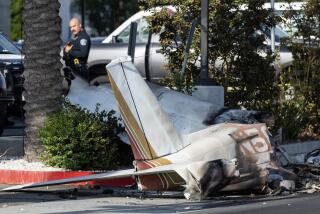Plane Crash in China Kills All 42 Aboard
BEIJING — A passenger plane apparently struck by lightning exploded in midair and crashed in central China on Thursday, killing all 42 people on board, Chinese state media reported.
At least four people on the ground were missing near Wuhan, the capital of Hubei province, the official New China News Agency reported.
The Chinese-built Yunshuji-7, a twin-engine turboprop that can carry up to 62 passengers, reportedly was struck by lightning about 3 p.m. as it descended for a landing in Wuhan, the news agency said. The Wuhan Airlines flight had originated in the small city of Enshi, about 300 miles to the west.
Witnesses said the plane had been sheared into at least two pieces. The dead consisted of 38 passengers and four crew members.
Rescue crews worked into the night to search the wreckage, which was concentrated in a clump of trees on the banks of the Han River, a tributary of the Yangtze, the news agency reported in updates today. Most of the victims’ bodies had been recovered by 8 p.m. Thursday, as anxious relatives awaited word.
Falling pieces of the plane apparently knocked several workers from a nearby tile factory--believed to be among the missing--into the river. At least four corpses were fished from the waters, the news agency said.
One of the aircraft’s two “black box” recorders also was recovered from the river and an official investigation launched, the agency said.
Aviation experts in the United States said that planes frequently are struck by lightning but that damage tends to be minimal.
“Normally, it’s not a big problem,” said Gene Doub, an air safety investigator with the federal Transportation Safety Institute in Oklahoma City. “Everything usually is so well grounded that the lightning just dissipates itself.”
However, Doub and Andy McMinn, an instructor at the institute, said there have been rare instances when the grounding was inadequate and the lightning arced, igniting vaporized fuel and causing on-board explosions.
Both men stressed that information about the Chinese crash is still too sketchy to assume that that is what happened to the Yunshuji-7.
Doub and McMinn said that even if the grounding was inadequate, the kerosene vapors in the plane’s fuel tanks would not ignite easily.
“To get the vapors to explode, you have to have just the right air-to-fuel mixture, and that’s a very narrow band,” McMinn said.
The pilot of the downed plane had requested permission to land about 2:50 p.m. but was told to fly back to Enshi because of the storm, official media reported. At 2:54 p.m., he radioed for help. The line then went dead.
After the accident, Wuhan Airlines announced that it was suspending flights on its six remaining Yunshuji aircraft.
The Yunshuji-7, manufactured by the Xian Aircraft Manufacturing Corp., is China’s largest domestically made passenger plane. The first one took flight in 1984, and the last one rolled off assembly lines in 1990. About 65 Yunshuji-7s were in service as of 1997, the most recent figures available. Most of the aircraft are flown domestically.
For years, the Yunshuji-7 series was the workhorse of this nation’s civil aviation industry. In recent years, however, domestic airlines have updated their fleets with newer Boeing and Airbus aircraft and phased out Chinese- and Russian-built airliners.
Many of the Yunshuji-7s are flown on secondary routes plied by the smaller, regional airlines that have proliferated in China over the last decade. Few, if any, Yunshuji-7 models are used for flights out of major cities such as Beijing and Shanghai.
An aviation expert told the China Daily newspaper last month that the planes are nearing the end of their working life.
China has worked hard to improve its air safety record since a rash of accidents in the early 1990s. In 1992, three crashes claimed 261 lives. Two years later, the country experienced its worst accident in history: the explosion of a China Northwest Airlines plane, which left 160 people dead.
China’s most recent air disaster occurred in February 1999, when a Russian-made Tupolev-154 passenger plane spun out of control and crashed as it approached the eastern coastal city of Wenzhou. More than 60 people were killed.
As part of its effort to improve safety, the government will spend $1.2 billion on upgrading air traffic control systems by 2010, the China Daily reported.
*
Chu reported from Beijing and Malnic from Los Angeles.
(BEGIN TEXT OF INFOBOX / INFOGRAPHIC)
Lightning-Caused Crashes
Accidents in which aircraft involved were damaged beyond repair due to lightning strikes. Only airliner-type aircraft (capable of carrying 14-plus passengers) are listed.
*--*
Date Aircraft Location 6/26/59 TWA Lockheed Starliner Italy 8/12/63 Vickers Viscount France 20/20 12/8/63 Boeing 707 U.S. (Md.) 12/24/71 Lockheed Electra Peru 5/9/76 Boeing 747 Spain 9/5/80 Lockheed Hercules France 2/8/88 Swearingen Metro Germany
Date Fatalities/people on board 6/26/59 68/68 8/12/63 12/8/63 81/81 12/24/71 91/92 5/9/76 17/17 9/5/80 8/8 2/8/88 21/21
*--*
Source: Aviation Safety Network
More to Read
Sign up for Essential California
The most important California stories and recommendations in your inbox every morning.
You may occasionally receive promotional content from the Los Angeles Times.











